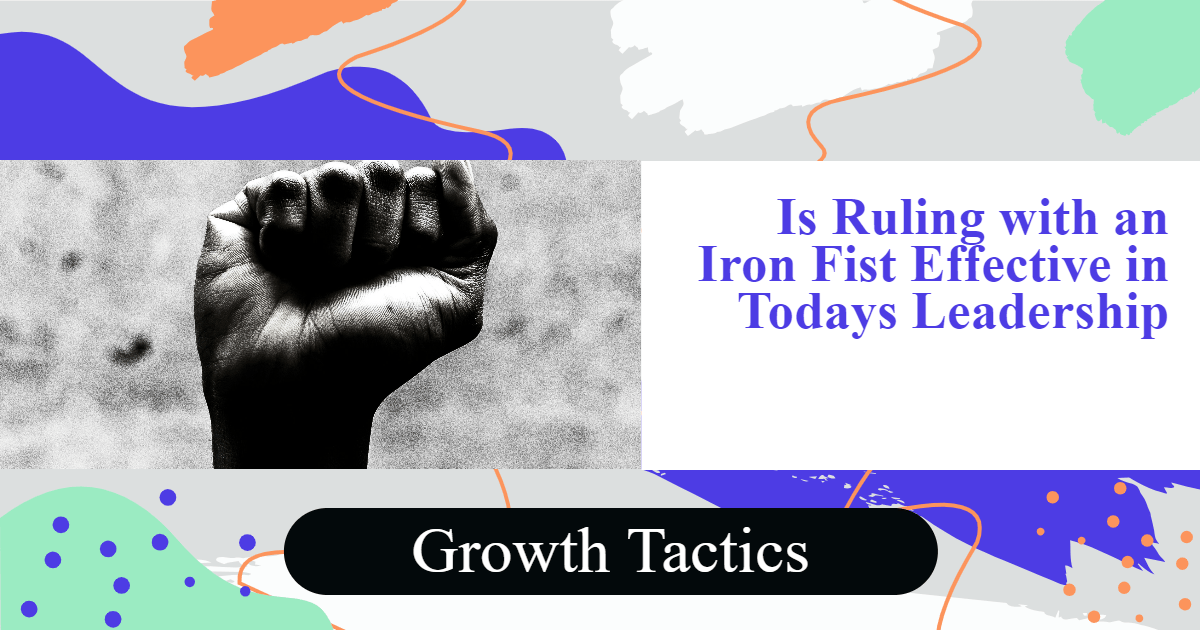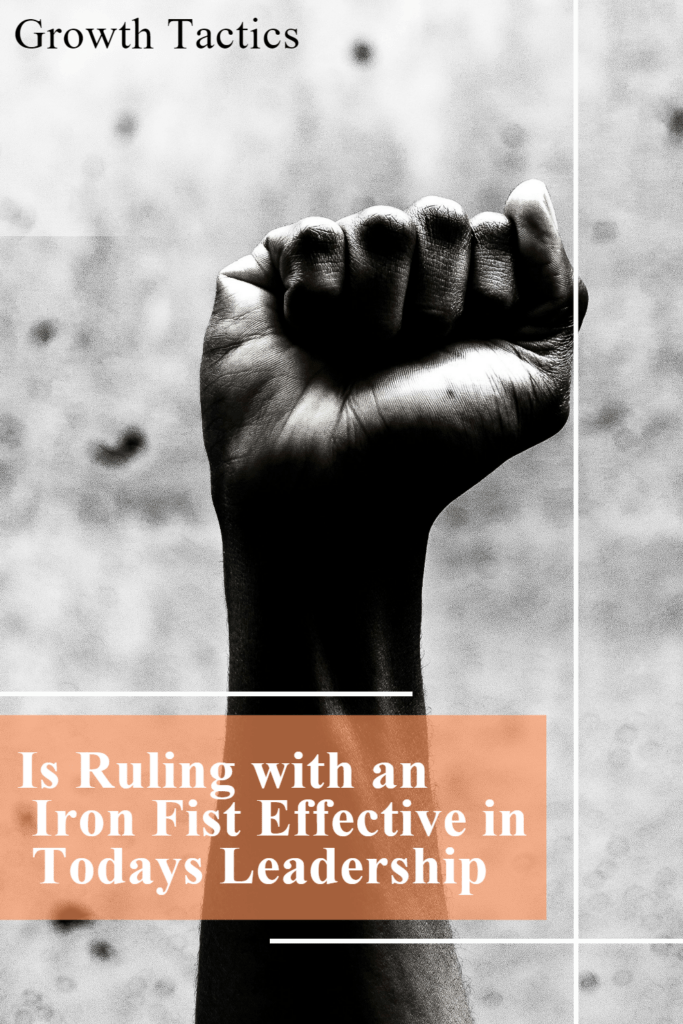The idea of ruling with an iron fist brings to mind images of power, control, and, sometimes, fear. Typically, it refers to leaders who rule with strict authority, enforce their commands as law, and do not tolerate dissent. While this approach has historical roots stretching back to empires and autocracies, its place in the contemporary leadership landscape warrants a closer look. This blog post seeks to explore the concept of iron fist leadership in detail. Weighing its effectiveness against the leadership demands of our current era.
Does Ruling With an Iron Fist Have a Place Today?
The phrase “iron fist” suggests a kind of leadership that leaves little room for debate. Traditionally, such leaders—be it kings or autocratic rulers—demand unwavering obedience, harnessing their power to suppress opposition and maintain control. While effective in the short term for quick decision-making and maintaining order. One wonders if such a rigid approach is viable in our more democratic and rights-focused world.

A Look Back at Iron Fist Leadership History
Rulers who exemplified the iron fist approach dot history. Believing their strict control was necessary to ensure societal stability and prosperity. This style of governance has been evident across different times and territories, from ancient China to Europe’s medieval kingdoms. However, these stories also highlight the dark side of such rule—oppression, unhappiness among the populace, and frequent uprisings.
The Impact of Strict Leadership
The concept of strict, or “iron fist,” leadership often brings about mixed reactions. On one hand, some see it as a necessary evil for making swift decisions and maintaining law and order during crises. However, the profound collateral damage it inflicts on a society’s psyche and the very fabric of its culture is significant. The high cost of such leadership manifests in various ways, from stifling fear to outright rebellion. Effectively underscoring the critical balance between authoritative control and the preservation of individual freedoms.
Historical and Contemporary Examples
Soviet Union under Joseph Stalin
Joseph Stalin’s regime in the Soviet Union is a prime example of iron fist leadership. It prioritized state control over personal freedoms. Stalin’s heavy-handed approach included severe repression, mass surveillance, and the Great Purge. Millions were either executed or sent to labor camps. Although Stalin transformed the Soviet Union into an industrial superpower, his leadership created a culture of fear and paranoia that stifled free thought and led to immense suffering.
North Korea’s Kim Dynasty
The Kim dynasty in North Korea, spanning three generations (Kim Il Sung, Kim Jong Il, and Kim Jong Un), has demonstrated the impacts of strict leadership on a contemporary society. The government’s tight control over all aspects of life, combined with its militaristic stance and the cult of personality, has led to widespread human rights abuses. Despite the adversities, the regime has managed to maintain its grip on power. Primarily through fear and the suppression of dissent.
Chile under Augusto Pinochet
Chile, under the rule of Augusto Pinochet from 1973 to 1990, faced brutal military dictatorship. The regime of Pinochet marked the suspension of civil liberties and suppressed opposition through censorship, torture, and executions. While some argue that Pinochet’s economic policies laid the groundwork for Chile’s later success, the cost in terms of human rights violations and the erosion of democratic institutions was profound.
The Psychological and Social Impact
The environments created by such strict governance are characterized by a significant atmosphere of fear and distrust. The psychological impact on citizens is profound—freedom of expression is curtailed, and the constant fear of surveillance and punishment stifles creativity and community spirit. Socially, this can create divisions within communities, as individuals might be compelled to inform on their neighbors to protect themselves, further degrading the social fabric.
Rebellion and Resistance
History has shown that while iron fist leadership might achieve short-term goals of stability and order. It often sows the seeds of long-term discontent and rebellion. Examples include:
- The fall of the Soviet Union, which was precipitated by widespread dissatisfaction with the government’s policies and the desire for greater freedom and openness that eventually led to its dissolution.
- The Arab Spring, a series of anti-government protests, uprisings, and armed rebellions that spread across much of the Arab world in the early 2010s. The movement was a direct response to the oppression and economic hardships faced under autocratic governance.

Psychological Underpinnings of Iron Fist Rule
Leaders who adopt the iron fist approach often see themselves as the ultimate guardians of society’s welfare, believing that their harsh methods are justified. However, citizens might view these actions as tyranny, resulting in fear and distrust instead of respect. This discrepancy raises doubts about the sustainability of such leadership in cultivating a cooperative and thriving society.
Modern Shifts in Leadership Style
Today’s world, with its emphasis on democratic values and human rights, views harsh leadership tactics as outdated. Current leadership models favor inclusiveness, empathy, and teamwork over unilateral decision-making and strict control. This shift reflects a broader understanding that effective leadership involves listening, understanding, and collaborating.
Ruling With an Iron Fist in Crisis Situations
Even as the tide turns towards more inclusive leadership, some argue that in specific crisis scenarios, a stronger hand is needed to navigate through chaos efficiently. However, this raises ethical questions: Can temporary measures become permanent? Is it worth compromising certain freedoms for the sake of order and safety?
Balancing Strength with Empathy: A Modern Leadership Paradigm
The adage “iron fist in a velvet glove” captures the essence of a leadership style that marries strength with sensitivity—a combination that has become increasingly relevant in today’s diverse and fast-paced world. This approach underscores the capacity of leaders to enforce rules and make tough decisions, while also prioritizing compassion, empathy, and understanding. Let’s dive deeper into how this balance can be achieved, highlighting examples and the positive outcomes it fosters.
Firm Yet Fair: The Foundation
This leadership style is rooted in the idea that one can be resolute without being oppressive and understanding without being overly permissive. It’s about setting clear boundaries and expectations, while also being open to dialogue and recognizing the importance of emotional intelligence. Leaders who master this balance can inspire loyalty, encourage innovation, and create an environment where both the organization and its people can thrive.
Examples of Leadership that Balances Strength with Empathy
Jacinda Ardern’s Response to Crisis
Jacinda Ardern, Prime Minister of New Zealand, exemplifies this balanced approach, particularly in her handling of the COVID-19 pandemic and the Christchurch mosque shootings. Ardern’s swift and decisive actions in implementing strict lockdown measures showcased her strength and decisiveness. Meanwhile, her empathetic communication and genuine care for her people’s well-being demonstrated her softer side, garnering global admiration.
Satya Nadella’s Transformation of Microsoft
Satya Nadella, CEO of Microsoft, is another notable example. Taking the helm of a global tech giant, he shifted the company culture towards one based on empathy, collaboration, and psychological safety. Nadella’s leadership not only revitalized Microsoft’s innovation but also dramatically improved its market performance. His approach illustrates how empathy does not only apply in times of crisis but also as an ongoing strategy for nurturing a creative and resilient organization.
The Positive Outcomes of a Balanced Leadership Approach
Enhanced Team Loyalty and Morale
When leaders demonstrate that they are strong yet approachable, it builds a sense of loyalty and trust among team members. Employees feel valued and understood, which in turn, enhances their morale and commitment to the organization’s goals.
Fostered Innovation and Creativity
A leadership style that embraces strength and empathy creates a safe environment for innovation. When team members feel supported and know that their ideas are welcome, it encourages out-of-the-box thinking and continuous improvement.
Improved Crisis Management
Crisis situations demand quick and decisive action, but they also require a sensitive understanding of the human elements involved. Leaders who can navigate this balance are better equipped to manage crises effectively, ensuring both the organization’s resilience and the well-being of its people.
Strengthened Public Image and Stakeholder Relations
Organizations led by individuals who embody both strength and empathy often enjoy a positive public image. This approach resonates not only with employees but also with customers, investors, and the wider community, fostering goodwill and strong stakeholder relations.

Learning from the Past
Looking back at history, we see the pitfalls of overly strict governance—rebellions, unhappy citizens, and the eventual downfall of regimes. These scenarios serve as lessons for today’s leaders, emphasizing the need for transparent, accountable, and inclusive governance models that adapt to societal changes and expectations.
Global Perspectives on Leadership
A global overview of leadership reveals a variety of approaches influenced by cultural, economic, and historical factors. This diversity enriches our understanding of governance, reminding us that there is no one-size-fits-all solution to leadership but rather a range of strategies shaped by context and community needs.
Concluding Thoughts on Ruling With an Iron Fist Today
In sum, while the iron fist model has its historical significance, its relevance and effectiveness in modern leadership are increasingly under scrutiny. Our evolving social norms and deeper insights into human dynamics advocate for a leadership model that values dialogue, empathy, and cooperation, paving the way for societies that flourish not out of fear, but mutual respect and shared goals.


